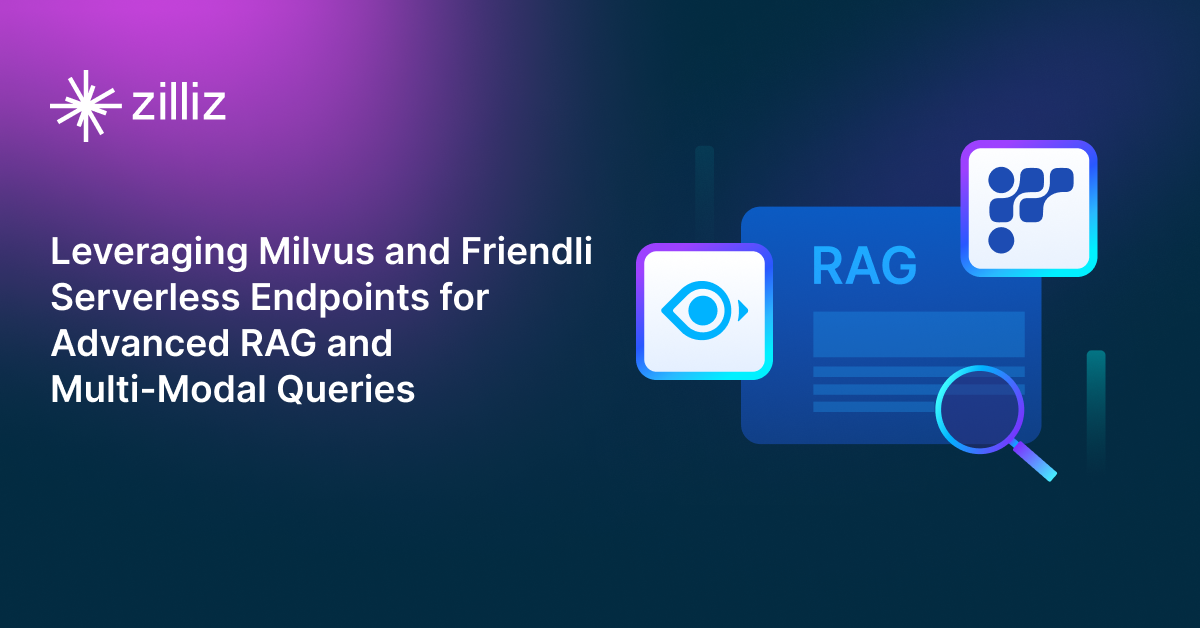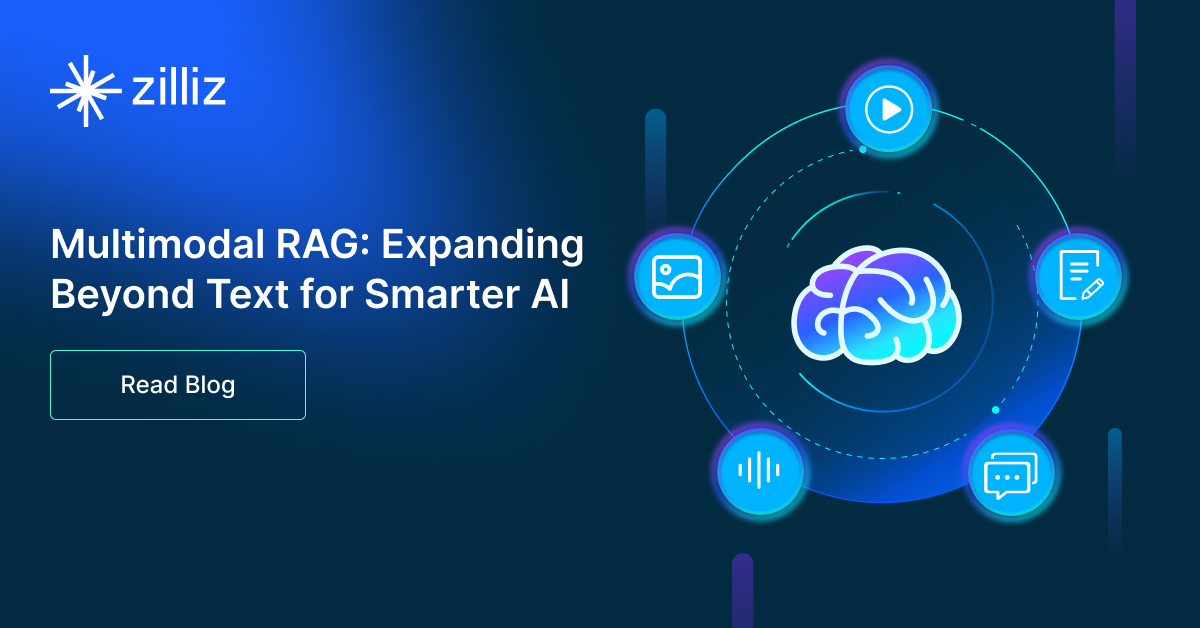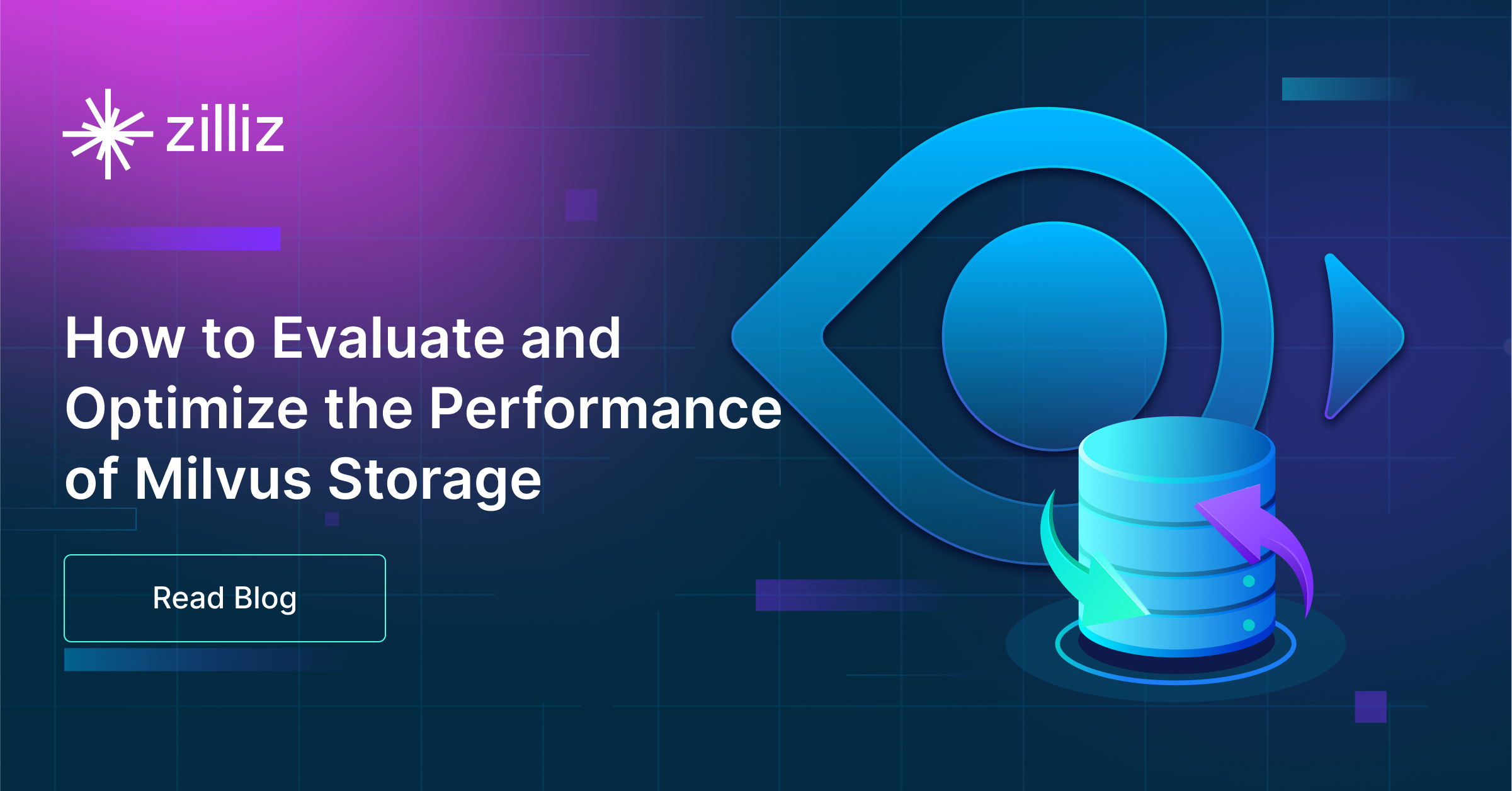Build RAG Chatbot with Haystack, OpenSearch, Anthropic Claude 3.7 Sonnet, and Optimum mpnet-base-v2
Introduction to RAG
Retrieval-Augmented Generation (RAG) is a game-changer for GenAI applications, especially in conversational AI. It combines the power of pre-trained large language models (LLMs) like OpenAI’s GPT with external knowledge sources stored in vector databases such as Milvus and Zilliz Cloud, allowing for more accurate, contextually relevant, and up-to-date response generation. A RAG pipeline usually consists of four basic components: a vector database, an embedding model, an LLM, and a framework.
Key Components We'll Use for This RAG Chatbot
This tutorial shows you how to build a simple RAG chatbot in Python using the following components:
- Haystack: An open-source Python framework designed for building production-ready NLP applications, particularly question answering and semantic search systems. Haystack excels at retrieving information from large document collections through its modular architecture that combines retrieval and reader components. Ideal for developers creating search applications, chatbots, and knowledge management systems that require efficient document processing and accurate information extraction from unstructured text.
- OpenSearch: An open-source search and analytics suite derived from Elasticsearch. It offers robust full-text search and real-time analytics, with vector search available as an add-on for similarity-based queries, extending its capabilities to handle high-dimensional data. Since it is just a vector search add-on rather than a purpose-built vector database, it lacks scalability and availability and many other advanced features required by enterprise-level applications. Therefore, if you prefer a much more scalable solution or hate to manage your own infrastructure, we recommend using Zilliz Cloud, which is a fully managed vector database service built on the open-source Milvus and offers a free tier supporting up to 1 million vectors.)
- Anthropic Claude 3.7 Sonnet: A versatile multimodal AI model optimized for enterprise applications, excelling in complex reasoning, multilingual tasks, and data analysis. Its strengths include rapid processing, high accuracy, and robust contextual understanding, ideal for content generation, customer support automation, R&D acceleration, and scalable AI-driven workflows. Combines performance with cost-efficiency for real-world deployment.
- Optimum mpnet-base-v2: A high-performance model designed for sentence-level tasks, Optimum mpnet-base-v2 is optimized for semantic textual similarity, classification, and retrieval applications. Its efficient architecture excels in both speed and accuracy, making it ideal for use cases in natural language understanding, search, and recommendation systems.
By the end of this tutorial, you’ll have a functional chatbot capable of answering questions based on a custom knowledge base.
Note: Since we may use proprietary models in our tutorials, make sure you have the required API key beforehand.
Step 1: Install and Set Up Haystack
import os
import requests
from haystack import Pipeline
from haystack.components.converters import MarkdownToDocument
from haystack.components.preprocessors import DocumentSplitter
from haystack.components.writers import DocumentWriter
Step 2: Install and Set Up Anthropic Claude 3.7 Sonnet
To use Anthropic models, you need an Anthropic API key. You can provide this key in one of the following ways:
- The recommended approach is to set it as the
ANTHROPIC_API_KEYenvironment variable. - Alternatively, you can pass it directly when initializing the component using Haystack’s Secret API:
Secret.from_token("your-api-key-here").
When configuring Anthropic models, make sure to define the Anthropic model you want to use by specifying it in the model parameter.
This component generates text based on a given prompt. Additionally, you can customize the generation process by providing extra parameters available in the Anthropic Messaging API. These parameters can be passed using generation_kwargs, either during initialization or when calling the run() method. To explore all available options, refer to the Anthropic documentation.
Finally, the run() method requires a single string as input to generate text.
Now let's install the anthropic-haystack package to use the AnthropicGenerator:
pip install anthropic-haystack
from haystack_integrations.components.generators.anthropic import AnthropicGenerator
generator = AnthropicGenerator(model="claude-3-7-sonnet-latest")
Step 3: Install and Set Up Optimum mpnet-base-v2
Haystack's OptimumTextEmbedder embeds text strings using models loaded with the HuggingFace Optimum library. It uses the ONNX runtime for high-speed inference. Similarly to other Embedders, this component allows adding prefixes (and suffixes) to include instructions. For more details, refer to the Optimum API Reference.
pip install optimum-haystack
from haystack_integrations.components.embedders.optimum import OptimumTextEmbedder
from haystack.dataclasses import Document
from haystack_integrations.components.embedders.optimum import OptimumDocumentEmbedder
text_embedder = OptimumTextEmbedder(model="sentence-transformers")
text_embedder.warm_up()
document_embedder = OptimumDocumentEmbedder(model="sentence-transformers/mpnet-base-v2")
document_embedder.warm_up()
Step 4: Install and Set Up OpenSearch
If you have Docker set up, we recommend pulling the Docker image and running it.
docker pull opensearchproject/opensearch:2.11.0
docker run -p 9200:9200 -p 9600:9600 -e "discovery.type=single-node" -e "ES_JAVA_OPTS=-Xms1024m -Xmx1024m" opensearchproject/opensearch:2.11.0
Once you have a running OpenSearch instance, install the opensearch-haystack integration:
pip install opensearch-haystack
from haystack_integrations.components.retrievers.opensearch import OpenSearchEmbeddingRetriever
from haystack_integrations.document_stores.opensearch import OpenSearchDocumentStore
document_store = OpenSearchDocumentStore(hosts="http://localhost:9200", use_ssl=True,
verify_certs=False, http_auth=("admin", "admin"))
retriever = OpenSearchEmbeddingRetriever(document_store=document_store)
Step 5: Build a RAG Chatbot
Now that you’ve set up all components, let’s start to build a simple chatbot. We’ll use the Milvus introduction doc as a private knowledge base. You can replace it your own dataset to customize your RAG chatbot.
url = 'https://raw.githubusercontent.com/milvus-io/milvus-docs/refs/heads/v2.5.x/site/en/about/overview.md'
example_file = 'example_file.md'
response = requests.get(url)
with open(example_file, 'wb') as f:
f.write(response.content)
file_paths = [example_file] # You can replace it with your own file paths.
indexing_pipeline = Pipeline()
indexing_pipeline.add_component("converter", MarkdownToDocument())
indexing_pipeline.add_component("splitter", DocumentSplitter(split_by="sentence", split_length=2))
indexing_pipeline.add_component("embedder", document_embedder)
indexing_pipeline.add_component("writer", DocumentWriter(document_store))
indexing_pipeline.connect("converter", "splitter")
indexing_pipeline.connect("splitter", "embedder")
indexing_pipeline.connect("embedder", "writer")
indexing_pipeline.run({"converter": {"sources": file_paths}})
# print("Number of documents:", document_store.count_documents())
question = "What is Milvus?" # You can replace it with your own question.
retrieval_pipeline = Pipeline()
retrieval_pipeline.add_component("embedder", text_embedder)
retrieval_pipeline.add_component("retriever", retriever)
retrieval_pipeline.connect("embedder", "retriever")
retrieval_results = retrieval_pipeline.run({"embedder": {"text": question}})
# for doc in retrieval_results["retriever"]["documents"]:
# print(doc.content)
# print("-" * 10)
from haystack.utils import Secret
from haystack.components.builders import PromptBuilder
retriever = OpenSearchEmbeddingRetriever(document_store=document_store)
text_embedder = OptimumTextEmbedder(model="sentence-transformers")
text_embedder.warm_up()
prompt_template = """Answer the following query based on the provided context. If the context does
not include an answer, reply with 'I don't know'.\n
Query: {{query}}
Documents:
{% for doc in documents %}
{{ doc.content }}
{% endfor %}
Answer:
"""
rag_pipeline = Pipeline()
rag_pipeline.add_component("text_embedder", text_embedder)
rag_pipeline.add_component("retriever", retriever)
rag_pipeline.add_component("prompt_builder", PromptBuilder(template=prompt_template))
rag_pipeline.add_component("generator", generator)
rag_pipeline.connect("text_embedder.embedding", "retriever.query_embedding")
rag_pipeline.connect("retriever.documents", "prompt_builder.documents")
rag_pipeline.connect("prompt_builder", "generator")
results = rag_pipeline.run({"text_embedder": {"text": question}, "prompt_builder": {"query": question},})
print('RAG answer:\n', results["generator"]["replies"][0])
Optimization Tips
As you build your RAG system, optimization is key to ensuring peak performance and efficiency. While setting up the components is an essential first step, fine-tuning each one will help you create a solution that works even better and scales seamlessly. In this section, we’ll share some practical tips for optimizing all these components, giving you the edge to build smarter, faster, and more responsive RAG applications.
Haystack optimization tips
To optimize Haystack in a RAG setup, ensure you use an efficient retriever like FAISS or Milvus for scalable and fast similarity searches. Fine-tune your document store settings, such as indexing strategies and storage backends, to balance speed and accuracy. Use batch processing for embedding generation to reduce latency and optimize API calls. Leverage Haystack's pipeline caching to avoid redundant computations, especially for frequently queried documents. Tune your reader model by selecting a lightweight yet accurate transformer-based model like DistilBERT to speed up response times. Implement query rewriting or filtering techniques to enhance retrieval quality, ensuring the most relevant documents are retrieved for generation. Finally, monitor system performance with Haystack’s built-in evaluation tools to iteratively refine your setup based on real-world query performance.
OpenSearch optimization tips
To optimize OpenSearch in a Retrieval-Augmented Generation (RAG) setup, fine-tune indexing by enabling efficient mappings and reducing unnecessary stored fields. Use HNSW for vector search to speed up similarity queries while balancing recall and latency with appropriate ef_search and ef_construction values. Leverage shard and replica settings to distribute load effectively, and enable caching for frequent queries. Optimize text-based retrieval with BM25 tuning and custom analyzers for better relevance. Regularly monitor cluster health, index size, and query performance using OpenSearch Dashboards and adjust configurations accordingly.
Anthropic Claude 3.7 Sonnet optimization tips
Optimize prompts by structuring retrieved context with clear XML tags or markdown headers to enhance Claude’s parsing efficiency. Use dynamic context window management, prioritizing high-relevance chunks while truncating redundant content. Implement query-aware document reranking to surface critical information early. Fine-tune temperature (0.2-0.5) for factual consistency and enable streaming for latency-sensitive applications. Cache frequent query embeddings to reduce reprocessing overhead. Leverage system prompts to enforce response constraints and validate outputs against retrieval sources to mitigate hallucinations. Monitor token usage per API call to balance cost and performance.
Optimum mpnet-base-v2 optimization tips
To optimize the performance of Optimum mpnet-base-v2 in a Retrieval-Augmented Generation (RAG) setup, consider fine-tuning the model on domain-specific data to improve its understanding of specialized queries. Leverage batch processing for efficient inference and experiment with reduced precision (e.g., mixed-precision or FP16) to speed up computation without sacrificing much accuracy. For better retrieval performance, optimize your vector store by choosing an appropriate indexing strategy, such as HNSW or IVF, and ensuring the embeddings are well-aligned with the query space. Additionally, consider using a smaller version of the model for less complex tasks to balance speed and resource usage. Regularly monitor the retrieval quality and adjust hyperparameters, such as the number of nearest neighbors, for the best results.
By implementing these tips across your components, you'll be able to enhance the performance and functionality of your RAG system, ensuring it’s optimized for both speed and accuracy. Keep testing, iterating, and refining your setup to stay ahead in the ever-evolving world of AI development.
RAG Cost Calculator: A Free Tool to Calculate Your Cost in Seconds
Estimating the cost of a Retrieval-Augmented Generation (RAG) pipeline involves analyzing expenses across vector storage, compute resources, and API usage. Key cost drivers include vector database queries, embedding generation, and LLM inference.
RAG Cost Calculator is a free tool that quickly estimates the cost of building a RAG pipeline, including chunking, embedding, vector storage/search, and LLM generation. It also helps you identify cost-saving opportunities and achieve up to 10x cost reduction on vector databases with the serverless option.
 Calculate your RAG cost
Calculate your RAG cost
What Have You Learned?
Congratulations—you’ve just unlocked the power to build a cutting-edge RAG system from the ground up! By diving into this tutorial, you’ve learned how to seamlessly weave together Haystack’s flexible orchestration, OpenSearch’s lightning-fast vector search, Claude 3.7 Sonnet’s human-like reasoning, and mpnet-base-v2’s razor-sharp embeddings into a cohesive pipeline that breathes life into your data. You now understand how Haystack acts as the conductor, stitching components into a symphony of context-aware responses, while OpenSearch serves as your intelligent librarian, swiftly retrieving the most relevant documents. You’ve seen how mpnet-base-v2 transforms raw text into rich numerical meaning and how Claude 3.7 Sonnet elevates those insights into fluent, natural answers—all while maintaining cost-efficiency and scalability. The tutorial didn’t just stop at integration; you’ve also picked up pro tips like optimizing batch processing for speed, tweaking chunk sizes for precision, and even using the free RAG cost calculator to balance performance with budget—a game-changer for real-world applications!
Now, armed with these tools and insights, you’re ready to revolutionize how information flows through your projects. Imagine the chatbots you’ll supercharge, the research assistants you’ll create, or the enterprise knowledge bases you’ll transform. This isn’t just about following steps—it’s about unlocking a new dimension of AI-powered problem-solving. So go ahead! Experiment with hybrid search strategies, fine-tune your models for niche domains, or build that moonshot idea keeping you up at night. The RAG ecosystem you’ve mastered today is your launchpad. The future of intelligent applications isn’t just coming—it’s already here, and you’re holding the blueprint. Let’s build something extraordinary—one query, one innovation, one “aha!” moment at a time. Your next breakthrough starts now!
Further Resources
🌟 In addition to this RAG tutorial, unleash your full potential with these incredible resources to level up your RAG skills.
- How to Build a Multimodal RAG | Documentation
- How to Enhance the Performance of Your RAG Pipeline
- Graph RAG with Milvus | Documentation
- How to Evaluate RAG Applications - Zilliz Learn
- Generative AI Resource Hub | Zilliz
We'd Love to Hear What You Think!
We’d love to hear your thoughts! 🌟 Leave your questions or comments below or join our vibrant Milvus Discord community to share your experiences, ask questions, or connect with thousands of AI enthusiasts. Your journey matters to us!
If you like this tutorial, show your support by giving our Milvus GitHub repo a star ⭐—it means the world to us and inspires us to keep creating! 💖
- Introduction to RAG
- Key Components We'll Use for This RAG Chatbot
- Step 1: Install and Set Up Haystack
- Step 2: Install and Set Up Anthropic Claude 3.7 Sonnet
- Step 3: Install and Set Up Optimum mpnet-base-v2
- Step 4: Install and Set Up OpenSearch
- Step 5: Build a RAG Chatbot
- Optimization Tips
- RAG Cost Calculator: A Free Tool to Calculate Your Cost in Seconds
- What Have You Learned?
- Further Resources
- We'd Love to Hear What You Think!
Content
Vector Database at Scale
Zilliz Cloud is a fully-managed vector database built for scale, perfect for your RAG apps.
Try Zilliz Cloud for Free


